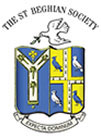|
 |
The Old St Beghian | |
| January 2021 | |||
J.D.S. (Tim) Brown (G 53-59) writes:
“I noted with sadness in the last Bulletin the passing of three of my contemporaries: John Pearcy, Julian Eldridge, and Hugh John Boulter. John I met up with again after many years through his friendship with Bill Greetham, and Julian was a near neighbour of mine in Ambleside.
Sadly, I lost touch with Hugh John in the busy years of university and professional training. During our time at school our lives crossed so many times. He was a new boy, like me, on Meadow House, in September 1953.
Michael Green was meant to be in charge of the new boys, but Hugh John instantly took over. He introduced himself as the son of a former Headmaster, and recounted that he’d been born on School House, so knew the area very well, and would show us around.
On the first Sunday of the term, he organised us on our bikes with a morning trip over the hill to Rottington. In the afternoon he gathered together a group of us to be a little more daring and we went to PL (Philip Lever) for a blue ticket. He congratulated us on our initiative, and Hugh John led the way to Ennerdale through the sad streets of Cleator and Cleator Moor. We had a picnic by the lake and set off back. Hugh John said he knew an easier way back, but it proved longer and steeper and he failed to negotiate one particularly nasty bend, somersaulting into a ditch. He emerged dripping blood and water, but had lost none of his exuberance. He was a very ebullient character with a very positive outlook.
He led the way on a later occasion, with ‘Wal’ Ingham and me, on a three-quarter day expedition to Keswick, on the route described by Charles Hedley in the last Bulletin, stopping to see the Bowder Stone.
Throughout my six years at school, I worked with Hugh John in the Library and on the school magazine. I believe he was Chairman of the Debating Society and, in that capacity, arranged for me to speak for the Labour Party in one debate - quite an achievement!Whilst at St Bees, I believe his father was then Rector of Satterthwaite, and I always envied Hugh John and his journeys to and from home on the little branch railway line up to Coniston.
How strange that I should park my car in what used to be Coniston Station only a week or two ago, and my thoughts went to Hugh John, wondering what had become of him. Sadly, I found out shortly afterwards that he had passed away.
The recent contributions to the Bulletin reminded me of some excellent cycling excursions on my new Hercules model (with 3-speed gears), and also of three-quarter days. In my first three terms on Meadow House I was regularly out on a blue ticket, either to Ennerdale or Eskdale. I do remember the Anglers Arms at Ennerdale, where, I think, we could have ham and eggs for tea for half a crown. Sadly it was demolished to make way for a reservoir, which never really happened - an act of vandalism.
On our return to Meadow one Sunday, when most boys had been out and about, I remember Philip Lever entering the dormitory that evening and urging us to sleep well as we might be in prison the next night. Apparently some boys had been to a quarry and managed to push some equipment over the top. I never knew the outcome of this, save to say that none of us went to prison!
Three-quarter days were memorable occasions for cycle rides, and my trip to Keswick was the longest. My favourite spot was Eskdale, where we could sit by the river with our packed lunch and have a bathe in the afternoon in one of the many pools. I remember also exploring Borrowdale and walking over towards Grasmere.
Occasionally the school would organise a Cumberland bus to deposit us for a walk. One strenuous walk I did, with Mark Turner, was from Borrowdale into Langdale and back, via Sty Head Pass. We indulged in a glass of cider in the Dungeon Ghyll hotel. Another time we were taken to Housesteads and walked along the Roman Wall to Chollerford for a nice afternoon tea at the George. On another occasion, with Peter Stewart and Bill Greetham, I climbed Ingleborough. It was a distressing occasion as it was at the height of the myxomatosis epidemic and our route was littered with sick and dead rabbits.
It was another forty years or so before I climbed it again, also with Bill Greetham, but this time with his wife, Ursula.
Years later, when I resumed acquaintance with my old English master, Paul Williams, I asked him if he, and other masters, used to check on our three-quarter day activities to see that nothing was amiss. 'Why should we?' he replied ' You all came back safely.' Enough said. We were all expected to use initiative and to assess risks for ourselves.”
Home
The St Beghian Society
St Bees School,
St Bees, Cumbria, CA27 0DS.
Tel: (01946) 828093 Email: osb@stbeesschool.co.uk
Web: www.st-beghian-society.co.uk
![]()